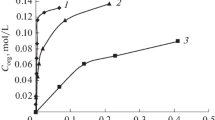Abstract
ALTHOUGH the separation of lithium, sodium and potassium by paper chromatography is not difficult, only three mixtures of solvents seem to have been proposed to accomplish the chromatographic separation of potassium, rubidium and cæsium. A. E. Steel1 recommended the use of a saturated solution of phenol in hydrochloric acid; but the chromatograms run under these conditions do not give reproducible R F-values. Separation has also been obtained by the method of C. C. Miller and R. J. Magee2, with a solvent consisting of concentrated hydrochloric acid/methanol/n-butanol/isobutylmethyl ketone (55 : 35 : 5 : 5 v/v). Recently, R. J. Magee and J. B. Headridge3 claimed better results for the chlorides of lithium and sodium, and of potassium, rubidium, cæsium and ammonium, using a phenol/methanol/concentrated hydrochloric acid mixture (57.5 : 22.5 : 20 per cent w/v/v).
Similar content being viewed by others
References
Steel, A. E., Nature, 173, 315 (1954).
Miller, C. C., and Magee, R. J., J. Chem. Soc., 3183 (1951).
Magee, R. J., and Headridge, J. B., Analyst, 82, 95 (1957).
Matthias, W., Der Züchter, 24, 313 (1954).
Author information
Authors and Affiliations
Rights and permissions
About this article
Cite this article
MODREANU, F., FISEL, S. & CARPOV, A. Paper Chromatography of Potassium, Rubidium and Cæsium. Nature 181, 1618–1619 (1958). https://doi.org/10.1038/1811618a0
Issue Date:
DOI: https://doi.org/10.1038/1811618a0
- Springer Nature Limited
This article is cited by
-
Rapid separation of alkali metal ions on zirconium antimonate paper
Chromatographia (1977)
-
Zur spektrophotometrischen Bestimmung von C�sium und Rubidium als Pikrate nach papierchromatographischer Trennung
Mikrochimica Acta (1966)
-
Radiochromatography of Alkali Ions
Nature (1958)




